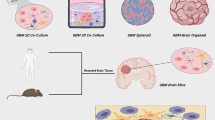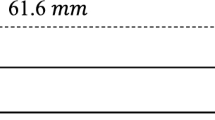Abstract
We present a multicompartmental model for an oxygen-carbon dioxide transport system. The compartmental equations and their lumped parameters are derived through space averaging of the corresponding distributed model. The model can predict compartmental distributions of oxygen and carbon dioxide partial pressures, oxygen-hemoglobin saturation, and pH. Other unique features include the effects of the radial distribution of partial pressures and the difference in metabolic rates between vessel wall and tissue. A model for the cat brain, based on this formulation, is compared with results of experiments and with two types of earlier models: one without space averaging and one without carbon dioxide transport. The results suggest that space averaging the convective terms significantly affects the behavior of the model. This is consistent with conclusions from our earlier oxygen-only model. Our observations also demonstrate, however, significant differences between the results from the oxygen-carbon dioxide model and the oxygen-only model. For instance, at low blood flow rates or at low level of oxygen input, predicted oxygen partial pressures can differ by as much as 30% between the two models. Results obtained from the present model are supported by available experimental findings.
Similar content being viewed by others
References
Aroesty, J., and J. F. Gross. Convection and diffusion in the microcirculation.Microvasc. Res. 2:247–267, 1970.
Austin, W. H., E. Lacombe, P. W. Rand, and M. Chatterjee. Solubility of CO2 in serum from 15 to 38°.J. Appl. Physiol. 18:301–304, 1963.
Beutler, E., and L. A. Wood. The in vivo regeneration of red cell 2-3-DipHospHoglyceric acid (DPG) after transfusion of stored blood.J. Clin. Lab. Med. 94:300, 1969.
Buerk, D. G., and E. W. Bridges. A simplified algorithm for computing the variation in oxyhemoglobin saturation with PH, PCO2, T and DPG.Chem. Eng. Commun. 47:113–124, 1986.
Davies, P. W., and D. W. Bronk. Oxygen tension in mammalian brain.Fed. Proc. 16:689–692, 1957.
Duling, B. R., W. Kuschinsky, and M. Wahl. Measurements of the perivascular PO2 in the vicinity of the pial vessels of the cat.Pflügers Arch. 383:29–34, 1979.
Douglas, A. R., N. L. Jones, and J. W. Reed. Calculation of whole blood CO2 content.J. Appl. Physiol. 65:473–477, 1988.
Gleightmann, U., D. H. Ingvar, D. W. Liibbers, B. K. Siesjo, and G. Thews. Tissue PO2 and PCO2 of the cerebral cortex, related to blood gas tensions.Acta Physiol. Scand. 55:127–138, 1962.
Gutierrez, G. The rate of release and its effect on capillary O2 tension: a mathematical analysis.Resp. Physiol. 63:79–96, 1986.
Hellums, J. D. The resistance to oxygen transport in the capillaries relative to that in the surrounding tissue.Microvasc. Res. 13:131–136, 1977.
Ivanov, K. P., A. N. Derry, E. P. Vovenko, M. O. Samilov, and D. G. Semionov. Direct measurements of oxygen tension at the surface of arterioles, capillaries and venules of the cerebral cortex.Pflügers Arch. 393:118–120, 1982.
Kelman, G. R. Calculation of certain indices of cardiopulmonary function using a digital computer.Resp. Physiol. 1:335–343, 1966.
Kelman, G. R. Digital computer procedure for the conversion ofPCo 2 into blood CO2 content.Resp. Physiol 3:111–115, 1967.
Kobari, M., F. Gotoh, Y. Fukuuchi, and K. Tanaka. Blood flow velocity in the pial arteries of cats, with particular reference to the vessel diameter.J. Cerebr. Blood Flow Metab. 4:110–114, 1984.
Lagerlund, T. D., and P. A. Low. Axial diffusion and Michaelis-Menten kinetics in oxygen delivery in rat peripheral nerve.Am. J. Physiol. 260:R430-R440, 1991.
Lassen, N., A. Ingvar, and D. H. Ingvar. The blood flow of the cerebral cortex determined by radioactive krypton85, Experientia 15:42–43, 1960.
Lee, J. E., F. Chu, J. B. Posner, and F. Plum. Buffering capacity of cerebrospinal fluid in acute respiratory acidosis in dogs.Am. J. Physiol. 217:1035–38, 1969.
Ma, Y. P., A. Koo, H. C. Kwan, and K. K. Chen. On line measurement of the dynamic velocity of erythrocytes in the cerebral microvessels in the rat.Microvasc. Res. 8:1–13, 1974.
Meldon, J. H. Computerized analysis of blood-gas equilibria, Part I: CO2 titration of oxygenated whole blood.Chem. Eng. Commun. 27:157–172, 1984.
Mochizuki, M. Kinetics of oxygen and carbon dioxide reactions. In: The Lung: Scientific Foundations edited by R. G. Crystal and J. B. West. New York, Raven Press, Ltd., 1991, pp. 1241–1250.
Monod, J., J. Wyman, and J. Changeaux. On the nature of allosteric transitions.J. Mol. Biol. 12:88–118, 1965.
Moskalenko, Y. E. Biophysical Aspects of Cerebral Circulation. Oxford, Pergamon Press, 1980.
Nair, P., W. J. Whalen, and D. Buerk.Po 2 of cat cerebral cortex: response to breathing N2 and 100% O2,Microvasc. Res. 9:158–165, 1975.
Nair, P. K., N. S. Huang, and J. D. Hellums. A simple model for prediction of oxygen transport rates by flowing blood in large capillaries.Microvasc. Res. 39:203–211, 1990.
Patton, H. D., A. F. Fuch, B. Hille, A. M. Scher, and R. Steiner. Textbook of Physiology. Philadelphia, W. B. Saunders Company, 1989, p. 952.
Popel, A. S., and J. F. Gross. Analysis of oxygen diffusion from arteriolar network.Am. J. Physiol. 237:H681-H689, 1979.
Popel, A. S. Theory of oxygen transport to tissue.Crit. Rev. Biomed. Eng. 17:257–321, 1989.
Reneau, D. D., Jr., D. F. Bruley, and M. H. Knisely. A mathematical simulation of oxygen release, diffusion, and consumption in the capillaries and tissue of the human brain. In. Chemical Engineering in Medicine and Biology, edited by D. Hershey. New York, Plenum Press, 1967, pp. 135–241.
Reneau, D. D., Jr., D. F. Bruley, and M. H. Knisely. A digital simulation of transient oxygen transport in capillary-tissue systems (cerebral grey matter).AIChE J. 15:916–925, 1969.
Roth, A. C., and K. Wade. The effects of transmural transport in the microcirculation: a two gas species modelMicrovasc. Res. 32:64–83 1986.
Schacterle, R. S., J. M. Adams, and R. J. Ribando. A theoretical model of gas transport between arterioles and tissue.Microvasc. Res. 41:210–228, 1991.
Severns, M. L., and J. M. Adams. The relation between Krogh and compartmental transport models.J. Theor. Biol. 97:239–249, 1982.
Sharan, M., M. D. Jones, Jr., R. C. Koehler, R. J. Traystman, and A. S. Popel. A compartmental model for oxygen transport in brain microcirculation.Ann. Biomed. Eng. 17:13–38, 1989.
Singh, M. P., M. Sharan, and A. Aminataei. Development of mathematical formulae for O2 and CO2 dissociation curves in the blood.IMA J. Math. Appl. Med. Biol. 6:25–46, 1989.
Stewart, P. A. How to Understand Acid-Base: A Quantitative Acid-Base Primer for Biology and Medicine, First edition: New York, Elsevier, 1981, pp. 110–145.
Ye, G-F., T. W. Moore, and D. Jaron, A compartmental model of oxygen transport derived from a distributed model: treatment of convective and oxygen dissociation properties. In. Proc. IEEE 18th Annu. Northeast Conf. Bioeng., edited by W. J. Ohley, New Jersey, IEEE, Inc., 1992, pp. 83–84.
Ye, G-F., T. W. Moore, D. G. Buerk, and D. Jaron. Coupling of oxygen and carbon dioxide transport in a compartmental model of cat brain. (Abstract) In: Program and abstracts of the Biomedical Engineering Society Third Annual Fall Meeting. Salt Lake City, Utah, 1992, H2.5.
Ye, G-F., T. W. Moore, and D. Jaron. Contributions of oxygen dissociation and convection to the behavior of a compartmental oxygen transport model.Microvasc. Res. 46:1–18, 1993.
Author information
Authors and Affiliations
Additional information
Deceased
Rights and permissions
About this article
Cite this article
Ye, GF., Moore, T.W., Buerk, D.G. et al. A compartmental model for oxygen-carbon dioxide coupled transport in the microcirculation. Ann Biomed Eng 22, 464–479 (1994). https://doi.org/10.1007/BF02367083
Received:
Revised:
Accepted:
Issue Date:
DOI: https://doi.org/10.1007/BF02367083




